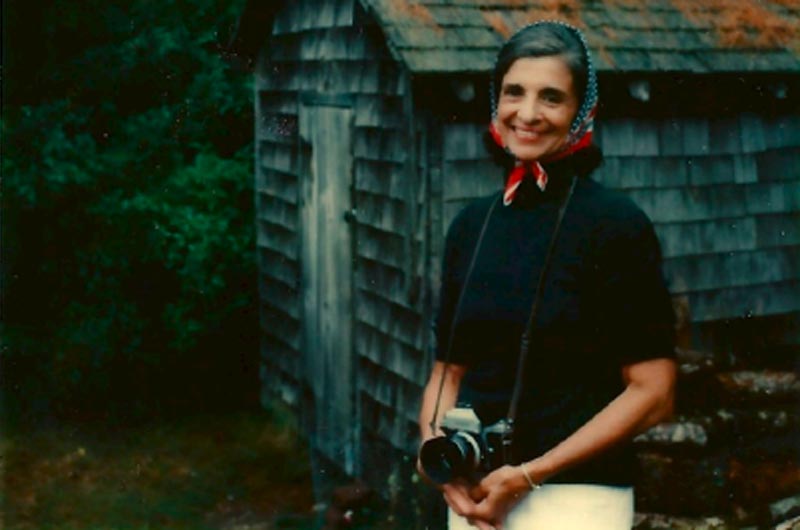A celebration of the life of Hilda Bijur — writer, photographer and longtime seasonal resident of West Tisbury — was held on April 12 at the Cosmopolitan Club in New York city, a women’s club of which she was a past president. Mrs. Bijur died at her winter home in New York in December at the age of 95.
In the early 1970s she first summered at Gay Head, where she rented the house of Duncan MacDonald. The Island appealed to her and in the mid 1970s, Mrs. Bijur bought a home of her own — an 1870s farmhouse, then known as the Pope house, at the end of New Lane in West Tisbury.
She was born in Greenwich, Conn., on Aug. 19, 1918, a daughter of Arthur Reis and the late Claire (Raphael) Reis and grew up in New York city. She was valedictorian of her class at the Lincoln School and went on to graduate in 1940 from Vassar College in Poughkeepsie, N.Y. Soon after graduation, she went to work as an editorial assistant at Theatre Arts Magazine, but when World War II broke out, she moved to Washington, D.C., to work for the American Red Cross, writing for a publication it was sending to servicemen. Among her assignments there was an interview with the two surviving Marines and the Navy corpsman who were among the five men made famous by the photograph taken of them raising the flag on Iwo Jima. Hilda would sometimes disparagingly describe her Red Cross job as “writing doughnut copy,” and she soon was longing to be the photographer rather than the writer on her assignments. At the end of the war she returned to New York, determined to learn more about photography.
Always purposeful, she went to the Museum of Modern Art to find out who they considered the best person with whom to study photography. Photography experts at the museum suggested the renowned German photographer Josef Breitenbach who had fled to New York at the start of the war. Soon Hilda was studying with him. Meanwhile, in 1952, she had married William Bijur, an advertising man, and they had started a family. In 1960, Bill Bijur died, leaving his widow with two children to raise — a son, Arthur, and a daughter, Victoria.
Within a week of her husband’s death, friends who were determined to take her mind off the tragedy and knew her enthusiasm for picture-taking invited her to Union Theological Seminary to take photographs of a production of T.S. Eliot’s Murder in the Cathedral in which they were performing. From then on, photography became a significant part of her life.
By 1965, when she felt her children were old enough to have her away some of the time, her love of picture taking, combined with a love of travel, led her to the United Nations in search of a job. Soon she was in Malta taking photographs of a U.N.-funded de-salinization plant. Over the next 10 years, she photographed extensively for the World Bank, providing pictures of their projects in the Ivory Coast, Senegal, Spain, Portugal, Yugoslavia, Jamaica, Mexico, Trinidad, Morocco and Israel. A devoted mother, she always managed to be at hand whenever her children needed her.
Both in New York and on the Vineyard, Hilda Bijur entertained family and friends with warmth and graciousness. In her early days in West Tisbury, she particularly enjoyed swimming at Lambert’s Cove and playing tennis with her longtime New York and Edgartown friend, the late Justine Priestley. Croquet was another favorite Island pastime. Always a lover of nature, in the field below her house, she had wildflowers planted, and in time when the walk to the beach at Lambert’s Cove became too much for her, she had a pool put in near the house. One summer, she and her neighbor, Nancy Woollcott Smith, worked together to produce the children’s book, Jason the Lobsterman, with Hilda taking the pictures of young Jason Gale and Nancy writing the text. She also exhibited her photographs at the Field Gallery.
In a 1985 interview with the Gazette, she was asked what advice she would offer to young and aspiring photographers. “One of the things I like so much about photography is that it only started in the mid-19th century,” she said. “So you really can know almost all about it. And if you acquaint yourself with the history of photography, that will lead you into the different schools, different styles.”
Hilda Bijur is remembered for her devotion and support of those around her, for being “a rock of Gibraltar” to family and friends, for her generosity and her wit, for her enthusiasm for the creative projects of her friends and family and for her determination and courage in her later years. “You always felt great in her presence,” one longtime friend remarked.
She is survived by her children, Arthur, of Amagansett, N.Y. and Victoria, of New York city; her son in law, Ed Levine and two grandchildren, William Levine of Los Angeles and Benjamin Bijur of Amagansett.
Contributions in her memory may be made to the Vineyard Conservation Society. Box 2189, Vineyard Haven 02568.


Comments (1)
Comments
Comment policy »